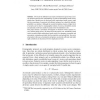Free Online Productivity Tools
i2Speak
i2Symbol
i2OCR
iTex2Img
iWeb2Print
iWeb2Shot
i2Type
iPdf2Split
iPdf2Merge
i2Bopomofo
i2Arabic
i2Style
i2Image
i2PDF
iLatex2Rtf
Sci2ools
CSL
2006
Springer
2006
Springer
Relating Two Standard Notions of Secrecy
Abstract. Two styles of definitions are usually considered to express that a security protocol preserves the confidentiality of a data s. Reachability-based secrecy means that s should never be disclosed while equivalence-based secrecy states that two executions of a protocol with distinct instances for s should be indistinguishable to an attacker. Although the second formulation ensures a higher level of security and is closer to cryptographic notions of secrecy, decidability results and automatic tools have mainly focused on the first definition so far. This paper initiates a systematic investigation of situations where syntactic secrecy entails strong secrecy. We show that in the passive case, reachability-based secrecy actually implies equivalence-based secrecy for signatures, symmetric and asymmetric encryption provided that the primitives are probabilistic. For active adversaries in the case of symmetric encryption, we provide sufficient (and rather tight) conditions on the proto...
Related Content
| Added | 22 Aug 2010 |
| Updated | 22 Aug 2010 |
| Type | Conference |
| Year | 2006 |
| Where | CSL |
| Authors | Véronique Cortier, Michaël Rusinowitch, Eugen Zalinescu |
Comments (0)

